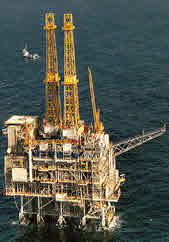Archive for December, 2015
The Oil Business
 In 1859, a salt miner known locally as “Uncle Billy” found oil at a depth of 69 feet in Titusville, PA. The well was owned by Edwin L Drake, and their find revolutionized the world.
In 1859, a salt miner known locally as “Uncle Billy” found oil at a depth of 69 feet in Titusville, PA. The well was owned by Edwin L Drake, and their find revolutionized the world.
The properties of oil were not unknown prior to Uncle Billy’s discovery. People found oil floating on top of water, seeping out of the ground, and sometimes in the form of tarballs drifting ashore. It was used for heating, illumination, and for various medicinal purposes.
In fact, what prompted Drake to drill a well near Titusville in the first place was oil floating on water there. After Drake’s well, hundreds of companies rushed to stake their claims. The majority, as is often the case, went bankrupt.
But, not everyone. John Rockefeller being one of the more notable exceptions. Within a decade of Drake’s discovery, the Standard Oil Company founded by him was one of the largest companies in the world.
It’s hard to overstate the importance of oil to modern life, and to the economic well being of everyone. Per Forbes Magazine, oil is directly responsible for about 2.5% of world GDP, but that’s nowhere near the whole story. Oil and natural gas account for over half of humanities primary energy supply.
Oil and Gas power 100% of modern transportation which is responsible for 17% of world wide GDP, and is deeply involved in all other economic activity.
Think about this.. IF oil and gas suddenly stopped flowing, civilization would collapse in a matter of months.
The same Forbes article has another interesting tidbit; at any given time, there is more oil seaborn, than there are fish in the sea. Oil is a huge part of modern life.
There is much talk about “renewables” as a replacement for oil and gas, but it’s only talk, no science. Oil alone, not even including natural gas, powers the world at about a 1500 X 1 ratio over renewables, and there is nothing on the horizon that is going to change that. Nothing.
The efficiency of solar, or wind, or biomass, or just about anything else you can think of pales next to oil. Again, if oil and gas stops flowing, renewables aren’t going to save you. World wide starvation and misery are the sure result.
Here’s the good news… the “peak oil” theory that was pushed a few years ago has proven wrong. We have more known natural gas reserves in the United States, for instance, than anytime since we started looking at it.
Advanced technologies can find and recover oil and gas in places and at rates hitherto thought impossible. And, there’s much more down there than we thought.
All of you remember the BP Oil spill, and all the news it got. The spill was terrible, but ironically, the bad news covered up some incredibly good news.
When the Macondo wellhead first blew, it was estimated that maybe 1000 barrels a day was leaking. Then upon further investigation, they raised that to 12,000 barrels, then to 25,000, and finally the best research from Woods Hole estimated that 60,000 barrels a day was blowing into the Gulf.
A terrible ecological problem, but overlooked was this fact.. BP had found a virtual river of oil. Very few people previously thought it possible.
Bottom line.. we have a LOT of oil and gas.
Interestingly, there are two theories about the origins of what we term fossil fuel. One is that it indeed does come from untold amounts of biological material mixing with clay over long periods of time. That’s the prevailing theory. But, there is another.
Pushed mainly by the late Cornell Astrophysicist Thomas Gold, these folks think that oil comes from the planet itself, and is being made today. Gold and his team actually made a hydrocarbon molecule in a lab experiment, and he later dared anyone to do the same with a “pot of ferns.”
Proponents of this theory point to long produced oil fields in the Gulf of Mexico, and which by all calculation should now be exhausted, seemingly refilling.
Tune in and hear more about it.
Driven to Business, hosted by Eddie Mayfield airs every Saturday at 11 AM on Atlanta’s Business radio, Biz 1190 AM. The show is streamed live on Biz1190.com and podcast on eddiemayfield.com and itunes.
Simply the best business radio in Atlanta.. Driven to Business.
There are ALWAYS business opportunities
 Business opportunities always exist. During the depths of the great depression, there were entrepreneurs who saw great opportunity and in fact, became wealthy.
Business opportunities always exist. During the depths of the great depression, there were entrepreneurs who saw great opportunity and in fact, became wealthy.
The trick is to look at the environment from a different angle. I heard a speech by famed quarterback Peyton Manning who said his job was to scan the field and see things that others don’t. Things such as where the safeties are lined up, and call an audible when prudent.
As a business leader, that’s your job as well.
Think all opportunities are gone? Read these quotes from the past:
- “Everything that can be invented has been invented.” Charles Duell, US Patent Office, 1899
- “The horse is here today, but the automobile is only a novelty-a fad” President of Michigan bank advising against investment in Ford.
- “What use could this company make of an electric toy?” Western Union turning down rights to the telephone.
When I was in the US Coast Guard, I had a chief electronic technician tell me, “This solid state stuff is not here to stay. Concentrate on tubes”
Do you get the pattern? Many, if not most, people fail to see trends and the opportunities they present. J. Paul Getty put his inheritance at great risk by buying depressed oil stocks when everyone else was dumping them. When the great depression ended and oil prices rose, he became a billionaire.
It’s not always true of course, that going the opposite direction of everyone else is a winner. But, in most cases, that is what winners do. The trick is to spot opportunities others are running away from.
Many business people fall into the trap of nostalgically longing for past times. “Things were great in the 90’s.” Well, the nineties are gone, and we live in what is the new normal. If you’re going to be successful, you must do it in the environment of now, not the past.
Change simply for change’s sake is a disaster. But, not adapting to a changing business environment is suicide.
Former GE Chairman Jack Welch said, “I am convinced that if the rate of change inside an organization is less than the rate of change outside, the end is in sight.”
For almost all businesses, whether you will change isn’t the question. You almost certainly will. But, will it be a healthy controlled change, or will it be a very unhealthy change forced on you by the market?
Businesses today face a rate of market change that is probably unparalleled. When I started my career, almost no one owned a computer. Now, about 85% percent of American households own at least one. The internet has grown even more rapidly, transforming almost all of modern life.
Not all changes are positive, in fact, many are frighteningly negative. But, the smart business person, like a good quarterback, looks over the heads of the team lined up against him and spots the holes.
Here are some examples.
- During hard economic times, companies tend to pull back on capital spending, but spend more on selected services such as maintaining their equipment. This presents great business opportunities to the discerning.
- With the increased cost of an employee, companies are outsourcing jobs they would have done in house in the past. Think opportunity.
- History shows us that during hard times, the entertainment industry flourishes.
- There are recession proof industries, like water and waste water treatment. Do you suppose that people flush their toilets less during bad times? (just to be clear.. they do not)
- China recently ended its atrocious one child per family rule. Aside from ending a morally reprehensible practice, it’s going to result in a huge baby boom, possibly the largest in history. For the smart entrepreneur, that should look like an opportunity.
Here’s one tried and true way of anticipating change. Ask your customers. What new needs do they have, that they didn’t have a few years ago? And since you’re the great business leader, why shouldn’t they use you to fulfill those needs?
Eddie Mayfield
Prospecting: Better do it!
 Learn this; customer attrition is a fact of life. No matter how good a job you do, you will lose customers. People die, companies go out of business, they get merged into other companies, they go a different direction, someone outsells you, or a myriad of other reasons.
Learn this; customer attrition is a fact of life. No matter how good a job you do, you will lose customers. People die, companies go out of business, they get merged into other companies, they go a different direction, someone outsells you, or a myriad of other reasons.
Consequently, you must hunt new customers. Let’s review some terms.
- A SUSPECT is someone that fits the general demographic of a customer, but with whom you have had no interaction
- A PROSPECT is someone with whom you have had some type of interaction. Could be from a website, phone call, email, or personal meeting.
- A LEAD is a prospect that you have qualified as a potential customer.
To begin; define your best prospect. Don’t fall into the trap of thinking “we sell to everyone, so everyone is a prospect. ” Trust me, they aren’t, and it’s dangerous to buy into that myth.
It’s not true that the bigger your market, the bigger your opportunities. Truthfully, the bigger your market, the more time you will spend spinning your wheels with people who are never going to be customers.
The more you can define your market, the more focused you can be, and the more effective and enjoyable your sales experiences will be.
Here’s a start, list your top customers, and look for common threads among them. Are they all from the same industry? Do they share common demographics, priorities, or workflow?
For each one, WHY do they buy from you? Don’t hurry through this, involve your team and get a consensus. Once you take these steps, you will know what traits you should be prospecting for and what your selling proposition should be.
Here’s an example from my world of electronic motor drives (See our website if you need further explanation of the technology)
- Many of our competitors are large multinational companies. Often they are very bureaucratic and slow to respond to customer needs.
Our customers buy from us, in part, because we respond quickly, and can make modifications or adjustments to their equipment without weeks of approvals. So, that is one of our selling propositions. We target customers that have become frustrated with the bureaucracies, and work hard to ensure they are happy with our service.
While compiling your top customer list, take care to do it correctly. The top billing customer, may not be your most profitable. Take things into account such as how much hand holding they require, if they beat you down on price, if they pay on time, and etc. All customers are NOT equal.
Once you determine what a prospect looks like, you can begin to concentrate on how to reach them.
Are you in a mature or an expanding market?
Generally, in a mature market, you will only get new business by taking it from a competitor. In an expanding market, you can get new business that didn’t exist before.
Here’s a good, and I hope encouraging question: How many people would use you IF only they knew you existed? Marketing is information, and information is marketing.
You can often uncover new prospects simply by being intentional about letting the market know you exist. This can vary from signs, to mailings, to trade shows, to traditional advertising, to websites, to social media.
Here’s a warning, prospecting is hard work. Sorry, it just is. However, it will pay huge dividends for you as time goes on.
So, get after it!
Eddie Mayfield
Driven to Business hosted by Eddie Mayfield is heard every Saturday on Atlanta’s business radio, Biz 1190 AM. The show is streamed live on biz1190.com and podcast on eddiemayfield.com and itunes.
Simply the best business radio in Atlanta. Driven to Business.
Who are your customers, and how do you find more like them?
 Learn this; customer attrition is a fact of life. No matter how good a job you do, you will lose customers. People die, companies go out of business, they get merged into other companies, they go a different direction, someone outsells you, or a myriad of other reasons.
Learn this; customer attrition is a fact of life. No matter how good a job you do, you will lose customers. People die, companies go out of business, they get merged into other companies, they go a different direction, someone outsells you, or a myriad of other reasons.
Consequently, you must hunt new customers. Let’s review some terms.
- A SUSPECT is someone that fits the general demographic of a customer, but with whom you have had no interaction
- A PROSPECT is someone with whom you have had some type of interaction. Could be from a website, phone call, email, or personal meeting.
- A LEAD is a prospect that you have qualified as a potential customer.
To begin; define your best prospect. Don’t fall into the trap of thinking “we sell to everyone, so everyone is a prospect. ” Trust me, they aren’t, and it’s dangerous to buy into that myth.
It’s not true that the bigger your market, the bigger your opportunities. Truthfully, the bigger your market, the more time you will spend spinning your wheels with people who are never going to be customers.
The more you can define your market, the more focused you can be, and the more effective and enjoyable your sales experiences will be.
Here’s a start, list your top customers, and look for common threads among them. Are they all from the same industry? Do they share common demographics, priorities, or workflow?
For each one, WHY do they buy from you? Don’t hurry through this, involve your team and get a consensus. Once you take these steps, you will know what traits you should be prospecting for and what your selling proposition should be.
Here’s an example from my world of electronic motor drives (See our website if you need further explanation of the technology)
- Many of our competitors are large multinational companies. Often they are very bureaucratic and slow to respond to customer needs.
Our customers buy from us, in part, because we respond quickly, and can make modifications or adjustments to their equipment without weeks of approvals. So, that is one of our selling propositions. We target customers that have become frustrated with the bureaucracies, and work hard to ensure they are happy with our service.
While compiling your top customer list, take care to do it correctly. The top billing customer, may not be your most profitable. Take things into account such as how much hand holding they require, if they beat you down on price, if they pay on time, and etc. All customers are NOT equal.
Once you determine what a prospect looks like, you can begin to concentrate on how to reach them.
Are you in a mature or an expanding market?
Generally, in a mature market, you will only get new business by taking it from a competitor. In an expanding market, you can get new business that didn’t exist before.
Here’s a good, and I hope encouraging question: How many people would use you IF only they knew you existed? Marketing is information, and information is marketing.
You can often uncover new prospects simply by being intentional about letting the market know you exist. This can vary from signs, to mailings, to trade shows, to traditional advertising, to websites, to social media.
Here’s a warning, prospecting is hard work. Sorry, it just is. However, it will pay huge dividends for you as time goes on.
So, get after it!
Eddie Mayfield
Driven to Business hosted by Eddie Mayfield is heard every Saturday on Atlanta’s business radio, Biz 1190 AM. The show is streamed live on biz1190.com and podcast on eddiemayfield.com and itunes.
Simply the best business radio in Atlanta. Driven to Business.




